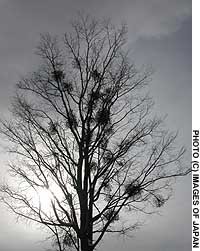Clumps of mistletoe, a parasite revered by pagans, grow in a towering Hokkaido elm.
Mistletoe magic
By Mark Brazil | Apr 3, 2003
THE GOLDEN BOUGHI am back in my local wood in Hokkaido yet again. From one spot, I can see the fluffed-out form of a Ural owl sunning itself at the entrance of its day roost, while looking in another direction and a little higher in the canopy of a towering elm, I find more than half a dozen spherical clumps, like strange squirrel dreys with a hint of dull green. Those clumps are Viscum album, otherwise known as mistletoe.
Owl and mistletoe is an odd pairing — were I more superstitious I might be torn between the deathly omen of the owl and the life-enhancing symbol of the mistletoe.
Japan’s mistletoes are evergreen parasitic plants that shun conifers and grow only on the branches of deciduous trees. The mistletoe’s fruit is a globular, smooth, white or red berry that ripens in December — a food source that thrushes, waxwings and bulbuls all find irresistible.
In eating the berries, the birds help disperse the mistletoe’s seeds. Sticky remnants of berries deposited by birds, either in their droppings or rubbed from their beaks, adhere to branches and soon send out fine roots that pierce the tree’s bark and attach themselves to the growing wood. A true parasite, the mistletoe appropriates all its nourishment from its host, and gives nothing in return.
Known as the Golden Bough, legends abound concerning the ancient mystical and magical powers of mistletoe. Sacred and mysterious, it was revered by the Druids, who gathered it with a golden sickle only at a particular phase of the moon, while clad in white robes. The Druids saw the miraculous mistletoe as affording protection from evil and illness, and it was widely credited with bestowing life and fertility as well as being deemed an aphrodisiac and a prophylatic against witchcraft and poison.
The Druids were more sophisticated than superstitious; they defined a precise calendar and used branches of the mistletoe to announce the transition from their Old Year into the New Year. Their ancient custom survives today in our propensity to hang sprigs of mistletoe among our Christmas decorations.
Today the European mistletoe is commonly found growing in old apple orchards, but it only rarely occurs on oak trees. In the past, the rarer oak mistletoe was greatly venerated as the “soul” of the oak, and early Europeans used it as a ceremonial plant.
Norse tragedy
Mistletoe has also been considered a sexual symbol. When a couple in love exchange kisses beneath the mistletoe, long a part of Christmas or New Year traditions, it is interpreted as a promise of marriage, and a prediction of happiness and long life.
This tradition is derived from a tragic ancient Norse tale about Balder the god of peace and his mother Frigg, goddess of love and beauty, which prompted William Shakespeare to call it “the baleful mistletoe.” In that Norse tale, the evil spirit Loki made an arrow of mistletoe wood and guided blind Hoder to fire it at his brother Balder. Balder was pierced through the heart, and killed. In one version, Frigg’s tears become the mistletoe’s white berries, in another Balder is restored to life at the request of the other gods and goddesses, and grateful Frigg overturned the mistletoe’s ill-repute by turning it into a symbol of love and promising to bestow a kiss upon anyone passing beneath it.
The mistletoe’s mythical protective properties aside, the leaves, young twigs, and berries of this member of the Loranthaceae family have long been used medicinally to treat a wide range of ailments, from nervous disorders, headaches and hypertension to epilepsy. It has also been used for heart disease, arthritis and rheumatism, and early herbalists recommended it for infertility, too.
However, it is one thing for the Golden Bough to be accorded healing powers by herbalists, another for it to be accepted by mainstream medicine. Nevertheless, mistletoe holds interest today, as a possible anticancer agent because extracts derived from it have been shown to kill cancer cells in vitro and to stimulate immune-system cells both in vitro and in vivo.
Several components of mistletoe that may be responsible for these effects, especially viscotoxins and lectins, have been investigated to differing extents. To date, it is thought that the viscotoxins — which are small proteins — may have cell-killing and immune-system stimulation properties. However, most research has focused on the lectins, which are complex molecules containing both protein and sugars that are capable of binding to the outsides of cells and inducing biochemical changes in them. Purified, these mistletoe lectins have been shown to possess both cytotoxic and immune system-modulating properties effective against a range of mouse, rat and human cancer cells grown in the laboratory.
If the mistletoe’s abilities to stimulate the immune system and limit the growth of cancerous cells can be conclusively demonstrated, then the Golden Bough once so highly respected by the Druids, may yet return to a place of veneration — not in the oak tree, as of yore, but in the modern medical pharmacopoeia.

